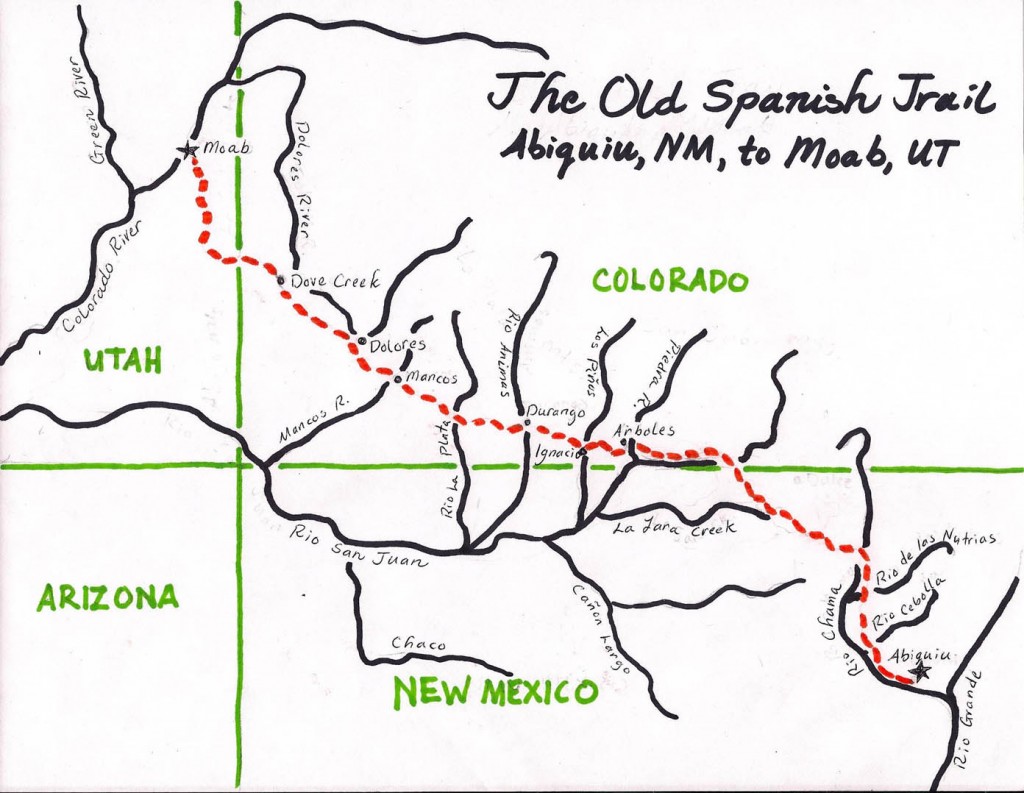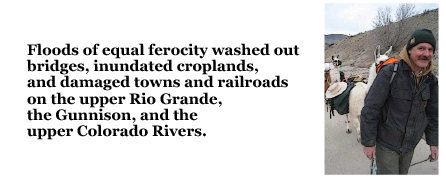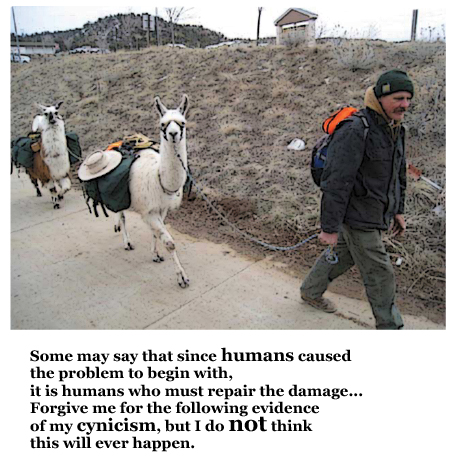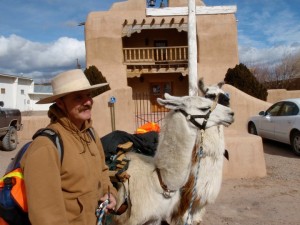THE WILLOWS of LA JARA CREEK
Following Ghosts Along the Old Spanish Trail
by Loch Wade
There is nothing remarkable about La Jara Creek. There are hundreds of minor tributaries in the San Juan basin, or even in the greater Colorado basin, that are just like it- intermittent streams, dry mostly, save for times of spring runoff and sudden summer flood. La Jara Creek originates along the low ridges of the Continental Divide that comprise the heart of the Jicarilla Apache Indian Reservation. From these ridges of cretaceous sandstone in northern New Mexico, the stream flows for almost 100 miles west-northwest to its confluence with the Rio San Juan. There is nothing remarkable about La Jara Creek, save for the irony of its name- “jara” in Spanish means willow. And, as I tramped along the upper reaches of the stream in the frigid days of February, 2011, I noticed that there are no willows along La Jara Creek.

I walked there because I followed the ghostly path of the Old Spanish Trail. I walked there alone, save for the not always pleasant company of two llamas, named Jasper and Chalcy. These creatures had been impressed, with a steadily growing resentment, into carrying my gear and supplies for a month-long excursion along the historic path. Once trod by Mexican traders in the decades between 1828-1848, the Main Branch of the Old Spanish Trail, (which I was following), wound in a general northwesterly direction from its start in Abiquiu, New Mexico. It would hold this northwesterly course for some 400 miles until it reached Green River, Utah. Here the trail would swing west and then southwest in a great arc that would eventually bring it 1200 miles to its terminus in Los Angeles. I was hoping, over the course of the next few weeks, to walk the easterly section of the trail from Abiquiu to Moab.

I reached the banks of La Jara Creek on my 8th day of travel. The weather was bitterly cold, with nightly temperatures plummeting to well below zero Fahrenheit along the high plateau that straddles the Continental Divide. The average elevation here is about 7500 feet. I saw very few people- a few Apaches passed in pickups as they checked their cattle out on the range allotments. A Jicarilla Reservation Game Warden stopped and asked me for my Tribal permits. The only other people I saw were gas field workers. They passed by in powerful four-wheel drive service trucks, loaded with air compressors, cranes, and arc welding equipment.
A few people stopped and asked me what I was doing, but most were anonymous; shadows encapsulated in their warm, rolling shells of glass and steel. They were ghosts along a lonely and ever more ghostly path through a winter land of silence, frost, and the faint echoes of the old, the unknown, the Once, But Now No Longer.
La Jara Creek, where my route touched it, skirted the western edge of a basalt outcropping called Dike Rock Ridge. This geographic anomaly ran before me in a long north-south line, a hardened upwelling of magma that jutted out of the surrounding layers of cretaceous sandstone like the disinterred bones of some ancient Leviathan. Its long, black back was knobby with eerie, cantilevered hoodoos, eroded fairy castles, and buttresses of crumbling basalt. The creek played tag with the dike for a mile or so, and then, it darted through a gap to the south, as if making for the first opportunity of escape. The bottomland around the creek was thinly dotted with wiezened junipers and pinons, sage and rabbitbrush. Dried clumps of chino grass clung wearily to the gray and friable clay of the overgrazed floodplain, and the creek itself- well, it was nothing more than a gully, ten to fifteen feet deep. At the bottom lay a frozen puddle of water about the size of a welcome mat. Sagebrush plants teetered to the edges of the gully, their roots hanging in midair, still clawing for purchase on ground that had been suddenly yanked from beneath them.
In all this, La Jara Creek was unexceptional. Willows? Of course there were no willows. Maybe some ground water ran along a hidden shelf of bedrock yet to be unearthed by the gnawing forces of flood, but there was no water table here. If water was to be found, it was hundreds, even thousands of feet below, trapped as fossil reserves in a deep and ancient sandstone aquifer.
Willows need water, and water was not to be had in La Jara Creek. But, as I said, none of this was exceptional, or even slightly different from any of dozens of watercourses I had encountered in my week’s walkabout. The Rio Cebolla had no onions growing along its sere and eroded banks. The Rio de Las Nutrias had probably not seen a beaver along its course for 180 years. Were I to take sections of these rivers and place them side by side with La Jara Creek, it would have been difficult to tell them apart. All were eroded gashes in the dun-colored earth; sere, wasted gullies, waterless, fringed with tired shreds of dried cheatgrass along an otherwise lifeless watercourse.
Yet La Jara Creek made me consider the fate of these streams. In the heyday of the Old Spanish Trail, the rivers of the New Mexican plateau, indeed the watercourses of all the upland Southwest, presented an entirely different character. They flowed in pools and meandering loops along the surface of broad, grass-covered floodplains, not it deep and inaccessible gullies as they do now. Dense clumps of willow and buffalo berry, groves of cottonwood and perhaps, in certain upland locations, aspen, adorned the banks of the lazy meandering streams which flowed from pool to limpid pool, the handiwork of legions of beaver, who dammed the streams and slowed the water in its passage along the valley floor.
The water table then lay scant inches beneath the surface of the ground, and the grass grew tall, until, as the saying goes, it brushed the horse’s bellies. Herds of elk, mule deer, even buffalo, grazed along the valley floors, providing ample food for grizzlies, wolves, and cougars. Only on the hillsides would one find sage and rabbitbrush, or clumps of chino grass. These were the dry zones. On the hillsides, the water lay too deep for thirstier plants. Pinons and junipers also grew on the wide hillsides, and never did these plants, adapted for dry conditions, venture down into the bottomlands.
The mechanics of the change is no mystery. Trappers led the first attack, and descended upon the country in the first decades of the 19th century. The New Mexican plateau was one of the richest trapping grounds in the West. In less than thirty years, the beaver were gone, felted away into the stylish hats of New York, London, and Paris.
As the beaver vanished like the fumes of mercury used in the felting process, their dams fell into disrepair, the cottonwood and willow sticks of their construction silvering and shrinking in the summer droughts. The dams broke away during spring runoff and autumn deluge, and were swept downstream. Now the water ran faster, and cut deeper into the soft clay soil.
Not 30 years passed before Anglo cattlemen brought their herds into the country, where they fattened on the long grasses of the bottomlands before being driven to the newly built train depots in Santa Fe, or to those on the plains of Texas and Oklahoma. The cattle were selective. They ate the sweetest and most palatable grasses, and left coarser and less palatable varieties alone.
Then, sheep were brought in, and they ate what remained. By 1900, 22,228,620 sheep grazed ranges in the Western states. The Navajo reservation alone boasted 1.72 million sheep and goats in 1892. In 1883, 5.2 million sheep munched away at New Mexico, and the number of sheep increased until well into the first decade of the 20th century. (By way of contrast, the 1900 census lists the entire human population of New Mexico as 195,310.)
By 1911, little vegetation remained. Every ponderosa, pinon, or juniper seedling, every aspen shoot, every blade and clump of grass, had been bitten off and eaten . Even the tree roots and grass rhizomes were pawed up and devoured. The bark of cottonwoods was eaten, and not a single willow remained that could be nibbled into oblivion by the ravenous herds. The herdsmen competed with each other for available range, and they followed the practice of “range wasting”, where they would deliberately overgraze a particular section to strategically deny forage to their competitor’s herds. Small gullies ran everywhere across the naked gray dirt- along the livestock trails, down small drainages, and of course, along the dessicated creek beds of every watercourse across the upper Southwest.
And then, in two days, it all washed away.
The trouble began a very long ways off, both in space and time. Above the African Continent, perhaps as early as June, a low level flow of air, the African Easterly Jet, had begun its long seasonal migration to the north. This low level stream of air is caused by a complex dynamic between temperature and soil moisture gradients that exist in the boundary between Saharan and sub-Saharan Africa. High above the dusty expanse of the Sudan, superheated air rose and began to create waves in the African Easterly Jet. These waves…subtle undulations in pressure…propagated westward across the Sahara, growing in intensity until they reached the Atlantic Ocean. These waves, now significant variations in atmospheric pressure, moved with a purposeful westwards motion across the tropical waters of the Atlantic.
Like swingers in a nightclub scene, the low pressure waves were in search of a particular set of existing conditions- a certain “chemistry” that would allow for the creation of a powerful, self-reinforcing dynamic. If revelers in a disco search for certain indefinable emotional and sexual compatibilities, the African low pressure waves, (now called “tropical waves”) were in search of certain specific and well defined ocean conditions…if seawater temperatures in excess of 27.5 degrees C, to a depth of 50 meters, were encountered by the tropical wave, a large amount of water vapor could be pulled into the atmosphere; if this warm water were combined with a steep atmospheric temperature gradient, rapid condensation would occur, releasing enormous amounts of heat energy into the moisture-laden air. Additional conditions would be even more propitious- a low wind shear in the upper atmosphere would allow for vertical convection, further increasing the energy release of the rising columns of air. If all of these conditions were to be found in an area north of 5 degrees latitude, Coriolis force would lend a cyclonic twist to the growing storm. With all the conditions in place, a tropical wave, just a blip of low pressure wafting across the tropical sea, would have the potential to develop into a tropical storm, or even into a hurricane.
In 1911, the tropical waves that emanated from the African Continent did not find conditions much to their liking in the Western Atlantic. There were only six tropical storms in that region that year. So the tropical waves kept moving, across Central America and Southern Mexico, and over the waters of the Eastern Pacific. Here, the conditions were just right for the formation of tropical storms.
Eleven known tropical cyclones formed in the Eastern Pacific in 1911. Largely this was caused by the El Nino effect (which also contributes, by increasing wind shear, to a decrease in Atlantic tropical storms). Essentially, an “El Nino” is a lessening of the strength of the equatorial trade winds. These winds normally push warm Pacific water westwards towards New Guinea and Australia. In 1911, the trades diminished in strength, allowing warm tropical water to remain close to the shores of the Americas.
So, in the last days of September, 1911, while the Basque, Navajo, Anglo and Hispanic sheepherders of the upper Southwest were busy guiding their flocks towards the last spindly grasses that survived on their overgrazed ranges, a tropical storm began to form two-thousand miles to the southwest. No-one knows the intensity of the storm. That it was able to push as far inland as the spine of the Rocky Mountains says something about its strength. But alone, this tropical intruder would have not been able to wreak the damage that it did. A lone Bonnie, no matter how cruel and bloodthirsty, needs a Clyde before she begins to wreak any serious or noteworthy havoc. The tropical depression that was born in the middle days of September, and which crossed overland as a fully developed cyclonic storm in the fist days of October, found her Clyde in a massive polar cold front that was, at the same time, pushing down out of the Gulf of Alaska and into the Pacific Northwest.
The two storms collided in much the same way that certain lovers, who perfectly accentuate each other’s worst self-destructive tendencies, collide. The place of their collision was over the crest of the San Juan Mountains; and if the tenuous analogy between sexual pyrotechnics and meterology can be tolerated just a bit longer, the collision of these two weather systems was positively orgasmic. How can anyone estimate the amount of energy released as the warm and cold air masses met, climbed atop one another, mixed, reformed, and eventually shed their combined passion in the form of rainfall? How many equivalents of how many nuclear bombs were expended in that momentous union? Were such a collision to occur today, we would have the opportunity to study it, to pick it apart, but of that storm a century ago, we have only the deductive picture we form rainfall measurements, the breathless accounts in local papers, and the silent witness of the gullies.
In a 36 hour period between October 5 and October 6, 1911, the Four Corners region, and larger areas of the four states of Utah, Colorado, New Mexico and Arizona, received between 2 and 4 inches of rainfall. In a region that averages about 11 inches of total precipitation each year, mostly in the form of snowfall in the higher elevations, a quarter of that amount, falling as liquid water in less than 48 hours, is a catastrophic event. For several days prior to the deluge, it rained steadily, and the soil of the denuded slopes, plains and ranges, already saturated with water, had no choice but to be taken away by the floodwaters as they sought a pathway towards the ocean.
In the San Juan River drainage, every bridge, (save for two on the Los Pinos River at Ignacio and La Boca) washed out, and the Denver and Rio Grande Railroad estimated that some 500,000 dollars (roughly 50 million in today’s dollars) worth of damage was done to its rail network. At least five people were carried away by the flood, and in downtown Durango, five feet of water flowed over Main Avenue near 15th Street. All the bridges in town were washed out, including the railroad bridge near the smelter, which had two loaded coal cars parked on it. An estimated flow of 150,000 cubic feet per second was recorded in Needles, California as the Colorado crested there a week later on the 11th of October.

Floods of equal ferocity washed out bridges, inundated croplands, and damaged towns and railroads on the upper Rio Grande, the Gunnison, and the upper Colorado Rivers. Total damages across the region were estimated at around two million dollars in 1911 money. In the aftermath of the flood, the human structures were not only quickly rebuilt, but improved- ten years later, the flood was no more than a tale, told whenever a particularly dramatic downpour occurred, until the event faded from living memory.
But the gullies remain. If you drive by a ragged gash in the gray dirt that is between ten and twenty feet deep, and slashes across a dusty sage bottom where nothing else grows save for a windblown clump or two of cheatgrass, chances are you are looking at the handiwork of the 1911 flood.
And it is this handiwork that I saw as I peered down into the gully that was La Jara Creek. This gully was the reason no willows grew here, along the watercourse that bore their name. The gully took the water table down with it. Deprived of water, the willows all died. Once gone, they took with them an entire ecosystem. More than a century later, the gully remained, evidence that something had been completely and irreparably broken. A century later, as I gazed down at the evidence of destruction, it occurred to me that the damage could not be fixed, not now, not ever. The very foundations had been washed away, and how could they now be replaced?
The willow was the base of the ecosystem that flourished along La Jara Creek before the sheepherders came, before the trappers came, even before the Navajo, Apache and Ute hunted along its marshy banks. How were the willows to be replaced? They could not grow because the gully had eroded until it had reached an impermeable stratum. Water now rushed along that substrate, and could not soak in as it once did in the softer soils above the present watercourse. The only way to restore the water table would be to retard the flow of water inside the gully. Dams or some sort of obstruction would have to be built, and who was going to build them, not just along the one hundred miles of La Jara Creek, but along the ten thousand miles of similarly eroded tributaries, all across the Southwest? The best dam builders in the world, the beaver tribe, could not do so, because there was nothing there for them to eat, and nothing for them to cut down and use as dam-building material. The willows would have to come first, before the beaver could come. And the willows could not come because the gully was too deep, and the water moved too fast. When Catch-22 reaches this place in the natural order of things, it denotes a permanent and irreparable breakdown of an ecological system.
Some may say that since humans caused the problem to begin with, it is humans who must repair the damage. Humans could, indeed, build dams in the gullies, and these dams would slow the rushing water. The silt and alluvium would build up, and the water table would slowly rise until, some day, willows could find a home in the deeper sandbars, and further slow the velocity of the stream. Eventually, maybe not even that many decades later, enough willows would grow to support the first colonies of beaver, and the watercourse would be well on its way towards restoration.
Forgive me for the following evidence of my cynicism, but I do not think this will ever happen. Money is what restores ecosystems when ecosystems cannot restore themselves, and humans must come to the rescue. The money, alas, is gone, gobbled up by desert housing developments, wars, derivatives, vampire banks, and endless iterations of Quantitative Easing. But there is a deeper reason for our economic malaise, and it lies in the phenomenon called Peak Oil.
If there is any truth to Peak Oil, which means we have passed the halfway mark of our global petroleum reserves, then as our energy supplies dwindle so do our monetary resources- energy deflation equals monetary deflation. Peak Oil and our current economic woes may actually be connected.

Imagine our monetary system as a sensitive indicator of future petroleum availability, a canary in the coal mine if you will pardon the analogy. Economic indicators, by nature more volatile than global petroleum production, are actually an advance warning system that is telling us the age of petroleum is soon to be over. A global money system of fiat debt-based currencies is staggeringly sensitive to energy supply fluctuations, because (think about it!) the ability to repay the staggering global debt load (some estimates of total debt exposure worldwide are in the multiple quadrillions of dollars) is drawn directly from energy inputs into the economy. Debt service equals energy input, and what will the bankers do, with their backs against the default wall, and given a choice between receiving usury and fixing a broken ecology?
This is why restoration of La Jara Creek is not high on anyone’s list of priorities, and I think it never will be.
I will go so far as to suggest that all ongoing environmental remediation efforts are totally doomed. Take the current Wal-Mart-funded Russian Olive and Tamarisk removal projects in the Escalante, Colorado, and Dolores basins. These projects are pure petro-centrism gone wild. The plan is to use chainsaws and powerful herbicides, as well as trucks and heavy equipment, to remove pesky Russian Olive trees from the riparian habitat. I don’t know why, but chainsaws and herbicides never made it onto my list of ecologically friendly tools. Today’s economic dislocations, caused by a looming Peak Oil reality tell me that Russian Olive removal will cease as soon as the current grant funds are exhausted. Does the Nature Conservancy want to buy more cattle ranches? Does SUWA want to sequester more rangeland as wilderness areas? Guess what? All dollars are petro-dollars, and the money for these projects will run out long before the last barrel of oil is sucked out of the ground.
The end of cheap oil is already heralded by the end of cheap money. The end of cheap money spells the doom of the conventional Environmental Industry. It was a good idea- to try to salvage, repair and resuscitate a landscape ravaged and misused by our species. For some, a few lawyers and lobbyists, it made for a comfortable living. As for the rest of us, our legacy will be the destroyed and ravaged landscapes that we call home. Take away our abundance of energy resources, and we lose the hubris to think we can fix what we destroyed. The new environmentalism will have to come to grips with the fact that what we have is.. well, all we have.
The toxic waste will never be cleaned up. The overgrazed ranges will never grow anything more than cheatgrass and the spiniest of Russian thistles. The uranium tailings will always continue to leach into the groundwater. The ten-thousand oil and gas boreholes will, for ever and ever, be conduits for contamination into the aquifers. The radioactive plumes from Fukushima will waft around the planet for centuries to come, as will future plumes from the other 400-odd nuclear power plants worldwide, all facing deterioration or meltdown as the money, energy, and resources to maintain them steadily diminishes.
Every morning, when I awoke to a snowstorm of hoarfrost inside my tent, and stumbled out into to the frigid winter air to begin my day’s walk in a silence of blue-cold skies; every day as I walked along, with only the squeak of my Sorels on the thin skim of snow to tell me sound even lived in the world, I had no choice but to take things as they came. Where I was, was… where I was. Be here now. I couldn’t change it- shit! Every mile I walked made it clearer that trying to “change it” was why things only got worse.
The spiritual masters all say that acceptance is the true pathway to change. Every supposed curse, when treated with the alchemy of acceptance, becomes a blessing. Thank God they won’t be able to eradicate Russian Olives- we’ll need that fast-growing hardwood for fuel, ox yokes, and shovel-handles in the not-too-distant future. Who knows what beneficial mutations will arise on a planet bathed in nuclear radiation? Ecosystems will never return to what they were, but eventually they will become something different, something just as amazing and beneficial in their delicate balances and efficient cycling of water, energy and nutrients. The keystone plants and animals may indeed be what we now call “invasives” or “exotics”. I predict that the zebra mussels, Asian carp, Russian Olives, and spotted knapweeds that make up the most-wanted list of today’s petro-centric environmentalists will someday, despite all the abuse to which we have treated them, become our saviors.

Attacking our environmental issues with more petroleum- whether it is in the form of a cattle ranch purchased with UnoCal petro-dollars, or in the form of a lawyer pecking at her smart-phone and FedEx-ing legal briefs, is not only foolish, it’s well beyond that. It is doomed, a relic of a bygone Gilded Age, and may not even last out the current decade. The end of cheap oil spells the renaissance of local, acceptance-based approaches to living on the planet. It sounds like a new and revolutionary concept, but it’s what traditional peoples have bee doing all along. “Working with” will replace “imposition on”, as the new environmental leitmotif.
Perhaps, maybe, the acceptance of unchangeable environmental realities will bring about a shift in our spiritual development, showing us that, in this present moment, things really aren’t so bad, or at least not so bad that they can’t be worse. In the present moment, it becomes obvious… most of our problems really are success problems. The Environmetalism of today, burdened as it is with the “ism” of ideology, politics, and “market-based initiatives” (er, money) is the sad story of a End that has been devoured by its Means. For all that (and I speak by way of eulogy), it was an attempt to gain an Ideal. There may never again be willows along La Jara Creek. And, we will someday discover that this is ok. For an Ideal can never manifest, save through a patient process of acceptance and resilient adaptation.
 Loch Wade lives in Garfield County, Utah
Loch Wade lives in Garfield County, Utah
To read the PDF version of this article, click here: oct11-20-21 and oct11-22-23
Don’t forget the Zephyr Ads! All links are hot:






I think the willows will come back.
I recently hiked the whole lajara creek valley and have hundreds of pictures of willows and thousands of other types of trees and vegetation. Also the creek flows lushly through the whole valley. I think you may have gotten the wrong valley. Instead of looking at the unfathomable beauty of this or any valley,you chose to dissect and distort what you observe as destruction instead of nature and time…..just remember , nothing is as it was fifty thousand years ago and nothing will be as it is in another fifty tbousand years. We are nothing more than a second in one of the many millenia that it took to create the breath taking beauty that I have had the honor of witnessing. ..but you are right about people they are a plague on the earth but in the end we are a force of nature ourselves albeit a dark one
I visited the wastelands of NM and thought I was cast into a hellish apocalypse or perhaps had dropped dead and been sucked down into a hell filled with tumbleweeds and brown-skinned demons 🙁